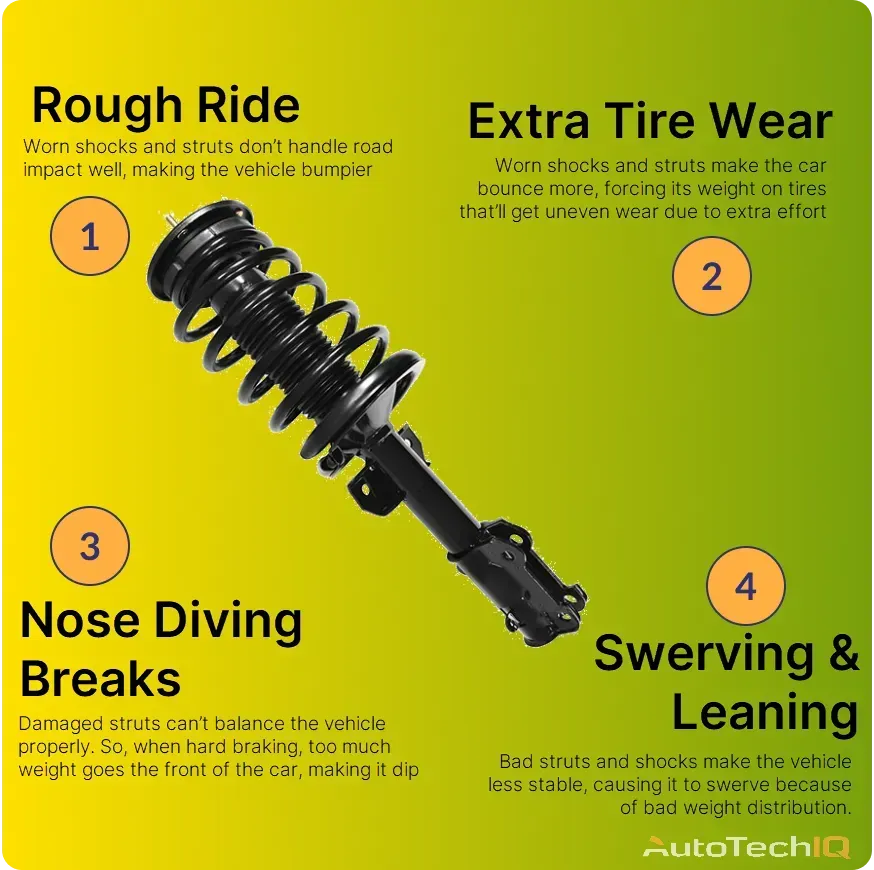
What are struts and shocks?
Struts and shocks are part of a vehicle's suspension system. They move through impact, controlling some springs and joints, ensuring a smoother ride. While shocks (short for shock absorbers) absorb impact and reduce bumps, struts connect shock absorbers with springs and other parts of the suspension. Struts and shocks enhance stability, comfort, and safety during driving.
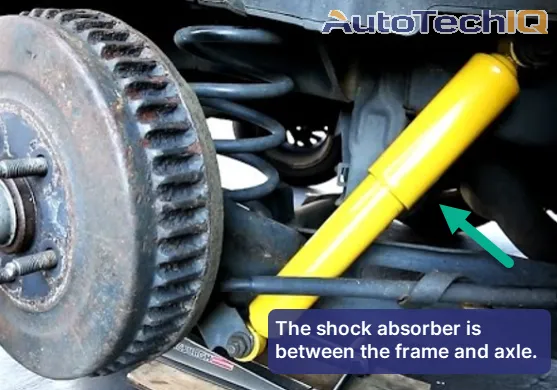
What does a bad strut sound like?
A bad strut commonly makes a knocking or clunking noise, especially when driving over bumps or rough roads. This sound often comes from the area where the bad strut is located, typically a corner of the car. Unfortunately, if the strut becomes too damaged, it might make creaking or groaning noises when the vehicle turns or changes direction. If any odd sound appears from the car, specifically at one of its corners, consider having a suspension check.
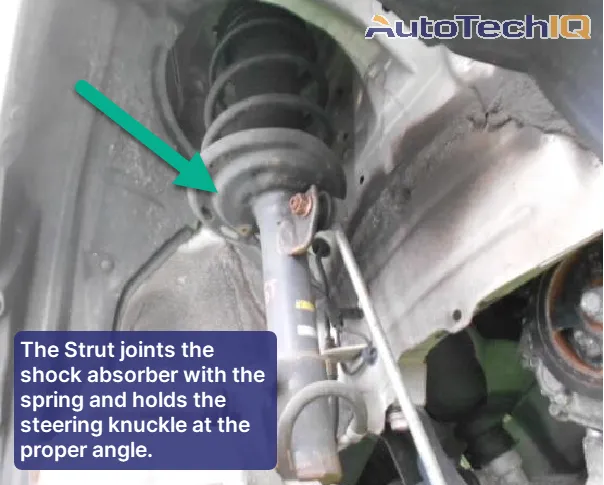
How much does it cost to replace shocks and struts?
There's no specific price since shocks and struts depend on vehicle make, model, and labor rates of the service shop. Additionally, it depends on your local area's shop practices and prices and if the car uses aftermarket parts. The best way to get an estimate is to talk with a trusted auto shop, as they will inspect the vehicle and recommend services accordingly. Shops also have experts who study the owner's driving habits, providing a tailored estimate.
Do I need an alignment after replacing the struts?
Yes. Struts are part of the vehicle's suspension and steering; they're connected to various metal rods and hidden joints under the vehicle's body. Replacing shocks and struts can alter the wheel position and alignment angles. So, after replacing the struts, aligning the wheels can avoid uneven tire wear, bad fuel efficiency, and tough handling. In most cases, an alignment check will detect a slight crookedness after a strut replacement.
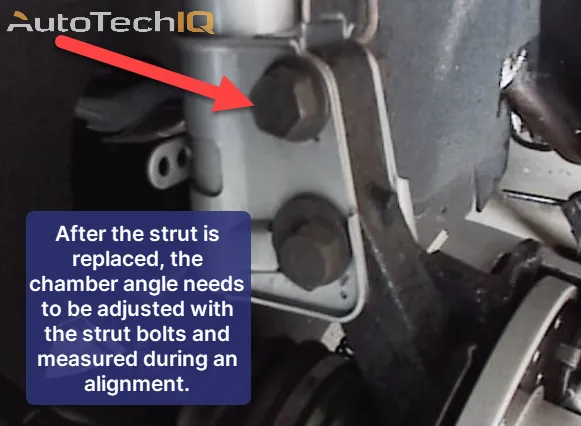
Are there any more symptoms that show my struts are bad?
When struts develop issues, they'll show some symptoms: the vehicle may feel bouncier on rough roads, make clunking or creaking noises, have fluid leaks, and show uneven tire wear. You can also look for physical damage on the struts; they're cylindrical parts surrounded by a spring behind the wheels. Also, if the car's steering is rough, especially when parking or turning, the struts are probably faulty.
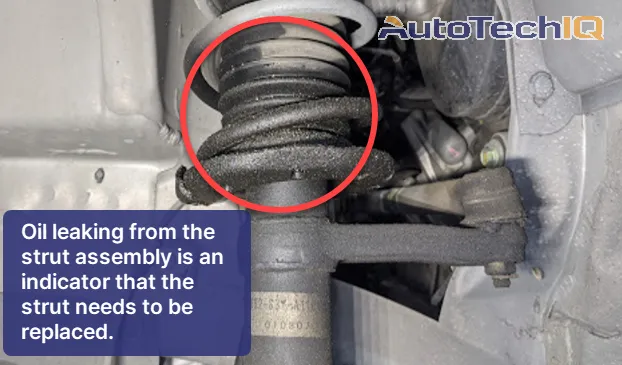
How often should struts be replaced?
Struts have a lifespan of 50,000 to 100,000 miles, which can vary based on driving conditions, vehicle weight, and road quality. Driving on rough roads or carrying heavy loads can damage struts. However, there isn't a strict mileage-based replacement rule, so it's essential to look for signs of wear or odd symptoms. Regular inspections by a professional can help set a proper replacement schedule.
What causes struts to go bad?
Struts can degrade due to normal wear and tear or extra factors. Regular driving on rough or bumpy roads, driving many miles per year, or carrying too much load are regular wear factors. Physical damage from accidents and exposure to road salts leading to corrosion are extra factors. Both factor types can damage struts quickly.
When replacing struts, should I replace other components?
When replacing struts, consider replacing related components like strut mounts, bearings, and coil springs. This extra measure is appropriate since these parts work along the struts and endure similar wear. Replacing them together can prevent future issues, improve the overall suspension system's longevity, and save on labor costs in the long run.
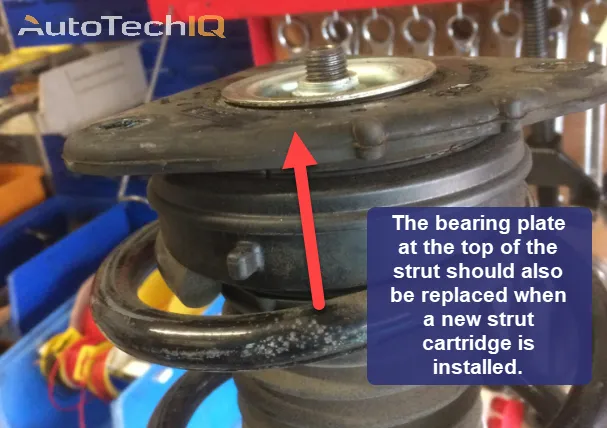
What are the most visible symptoms that bad Shocks and Struts cause?
The main symptoms that a faulty or worn-out shock and strut cause on a vehicle are these:
Rough Ride: Worn shocks or struts make the vehicle bumpier and less stable on uneven surfaces; that's because they don't efficiently absorb road bumps.
Excessive Bouncing: After a bump or a sudden stop, the vehicle might keep bouncing or jiggling. This issue indicates the shocks or struts aren't providing enough stability.
Uneven Tire Wear: Worn shocks and struts lead to uneven weight distribution. So, the car might push more on one side than the other, causing irregular tire wear patterns, such as cupping or scalloping. These issues often cause the car to shake when it's not supposed to.
Nose Diving on Stops: When braking, the vehicle's front end (nose) dips down noticeably, meaning the struts aren't maintaining proper balance. After braking, the car might continue shaking even while idle.
Swerving & Leaning: The car might lean too much when turning or swerving, indicating bad struts or shocks affecting the vehicle's stability. The steering wheel might also shake.
Fluid Leaks: Seeing oil or grease below the car means leaking fluid; the struts and shocks might also look greased. Leaks are critical and compromise the overall suspension's efficiency.
Knocking or Clunking Noises: Hearing unusual noises when driving over bumps or making turns indicates worn-out shock or strut components. In this case, the noises are typically clunking or knocking sounds.
How do shops identify and plan a strut and shock service?
Customers deserve transparency and convenience when trusting a repair shop with their vehicle. The most trustworthy shops follow comfortable guidelines to achieve customer happiness. Let's see an example of how shops with trained staff should receive customers, note their concerns, and proceed with a maintenance plan.
Maria, a concerned car owner, noticed issues while driving her car; there was extra bumping and bouncing on the road, making the ride uncomfortable. She decided to consult the local auto shop for expertise. At the shop, James, the technician, took charge:
Inspect: James started with a visual inspection of the shocks and struts. He took pictures of every wear sign and damage, including fluid leaks and any crookedness or bentness in the strut bodies.
Test: To understand the problems better, James took Maria's car out for a test spin. He tested the bounce while driving over speed bumps, noticing how the car was acting; he also detected a distinct nosedive when braking.
Evaluate: After returning to the shop, James showed the inspection images to Maria. He pointed out a strut with oily residue, revealing a leak. Then, he explained how important fluid is in shock absorption and how leaks are worrisome. He also pointed out the picture of a dented strut, linking it to the noises Maria had reported.
Diagnose: With enough test drive and visual examination, James saw a need for new shocks and struts on Maria's car. He educated her about the lower performance, safety risks, and potential for tire wear due to the worn components. He also offered a scheduled maintenance plan for Maria to avoid this issue from developing again.
Confirm Repair Completion: After repair, James took new pictures to show Maria, explaining the difference and pointing out the improvements. He also did an extra test drive to ensure everything was in order. Finally, he explained to Maria that her car was now safe to drive.
The main point of this personal treatment with customers is to have them exit the shop feeling confident. Car owners deserve to be happy about their ride's comfort and knowledge of how shocks and struts work in a vehicle.
What are the top 5 causes of damaged shocks and struts?
Normal Wear and Tear: Shocks and struts, unfortunately, aren't made to last forever. Over time, as with any car component, these parts will degrade with wear and tear; this happens at a convenient pace.
Road Conditions: Driving frequently on rough, potholed, or uneven roads can speed up the wear process of shocks and struts.
Physical Damage: Accidents and collisions cause an overall impact on the car's body, compromising shocks and struts.
Excessive Weight: Carrying heavy loads or towing can stress the shocks and struts, wearing them out faster.
Corrosion: Exposure to moisture, salt, and other corrosive materials can cause rusting or corrosion, affecting their material quality.
What are the top 5 fixes for vehicle shocks and struts?
Replacement: Replacement is typically the best route to get that initial comfort, handling, and safety the car had originally. Still, budget options can be more convenient depending on the recommended repair.
Strut Mount Repair: Repairing damaged strut mounts is essential to improve vehicle stability and alignment, even reducing noise.
Bushings Replacement: Worn-out bushings make clunking noises and reduce stability. They're recommended to be replaced instead of repaired.
Spring Replacement: Coil springs work with struts, enhancing suspension support and vehicle height. However, they can wear out and lose their effect, requiring replacement.
Alignment: After service or replacement on the suspension area, performing a wheel alignment is recommended. This alignment ensures good tire wear and better steering by keeping a good wheel placement.

Ok. That helped me understand shocks and struts better. What’s next?
As you've seen in this article, it's all about transparency when dealing with an auto shop. If the service advisor uses high-quality inspection images and explains every important aspect of them, educating the customer, the service will be positive. To ensure you're getting the same level of detailed analysis for your own vehicle, we invite you to visit our "Shop Near You" page. You'll find reputable auto shops near your area that provide these detailed inspections, focusing on personally helping you understand everything. Don't wait – discover trusted professionals close to you today!
Summary
Shocks and struts are vehicle suspension components that ensure ride comfort and safety. Over time, they can degrade with normal wear, rough road conditions, physical damage, excess weight, and corrosion. Recognizing the symptoms of worn-out shocks and struts is essential; these symptoms can be bouncy rides, odd sounds, and more. To address these issues, consider replacements and recommended repairs like changing bushings and springs or performing a wheel alignment. Finally, shops need to focus on educating their customers and getting rid of all their concerns through transparency; car owners deserve a comfortable and personal service.






